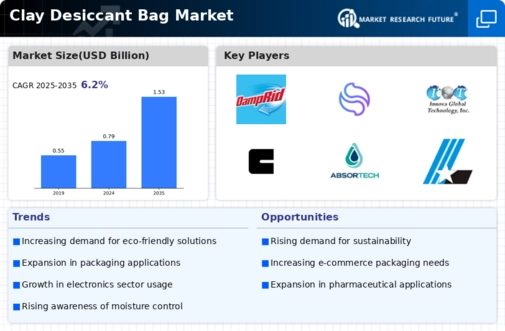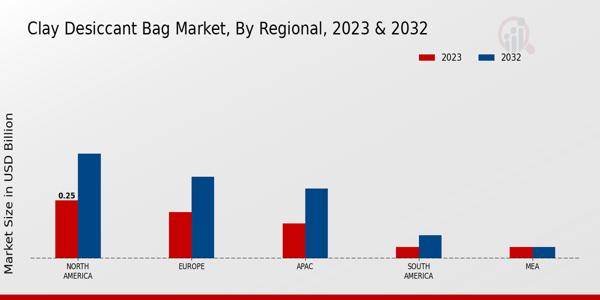Market Trends and Projections
The Global Clay Desiccant Bag Market Industry is poised for substantial growth, with projections indicating a market value of 0.79 USD Billion in 2024 and an anticipated increase to 1.53 USD Billion by 2035. This growth trajectory reflects a compound annual growth rate (CAGR) of 6.19% from 2025 to 2035. The market dynamics are influenced by various factors, including the rising demand for moisture control solutions, sustainability initiatives, and technological advancements in production processes. As industries continue to recognize the importance of effective moisture management, the clay desiccant bag market is expected to expand significantly in the coming years.
Expansion of E-Commerce and Online Retail
The expansion of e-commerce and online retail is significantly impacting the Global Clay Desiccant Bag Market Industry. With the rise of online shopping, there is an increased need for effective moisture control during the storage and transportation of goods. Clay desiccant bags are increasingly utilized in packaging to ensure that products remain dry and undamaged during transit. This trend is particularly evident in sectors such as electronics and fashion, where moisture can lead to product deterioration. As e-commerce continues to grow, the demand for clay desiccant bags is expected to rise, further solidifying their role in modern supply chains and logistics.
Sustainability and Eco-Friendly Practices
The Global Clay Desiccant Bag Market Industry is significantly influenced by the rising emphasis on sustainability and eco-friendly practices. Clay desiccants are naturally occurring materials, making them a preferred choice for companies aiming to reduce their environmental footprint. As consumers become more environmentally conscious, businesses are compelled to adopt sustainable packaging solutions. This shift is evident in the increasing production of biodegradable and recyclable desiccant bags. The market's growth is expected to be further bolstered by regulatory frameworks promoting sustainable practices, potentially leading to a market valuation of 1.53 USD Billion by 2035. This trend indicates a long-term commitment to environmentally responsible solutions.
Regulatory Compliance and Quality Standards
Regulatory compliance and adherence to quality standards are critical drivers of the Global Clay Desiccant Bag Market Industry. Various industries are subject to stringent regulations regarding product safety and quality, necessitating the use of effective moisture control solutions. Clay desiccant bags help companies meet these regulatory requirements by ensuring that products remain free from moisture-related damage. This compliance is particularly vital in sectors such as pharmaceuticals and food packaging, where product integrity is paramount. As regulatory frameworks evolve, the demand for reliable desiccant solutions is likely to increase, reinforcing the market's growth trajectory.
Growing Demand for Moisture Control Solutions
The Global Clay Desiccant Bag Market Industry experiences a notable increase in demand for effective moisture control solutions across various sectors. Industries such as pharmaceuticals, electronics, and food packaging are increasingly adopting clay desiccant bags to protect their products from moisture damage. This trend is driven by the need for maintaining product integrity and extending shelf life. As a result, the market is projected to reach 0.79 USD Billion in 2024, reflecting a growing awareness of the importance of moisture management in product quality. The adoption of clay desiccant bags is likely to continue rising as industries seek reliable solutions for moisture-related challenges.
Technological Advancements in Desiccant Production
Technological advancements in the production of clay desiccant bags are playing a crucial role in the Global Clay Desiccant Bag Market Industry. Innovations in manufacturing processes enhance the efficiency and effectiveness of desiccants, leading to improved moisture absorption capabilities. For instance, advancements in the granulation process allow for the creation of more uniform and effective desiccant particles. These improvements not only increase the performance of clay desiccants but also reduce production costs, making them more accessible to various industries. As a result, the market is likely to witness a compound annual growth rate (CAGR) of 6.19% from 2025 to 2035, indicating a robust growth trajectory driven by technological progress.




















Leave a Comment